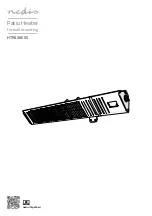
SER
VICE
22 • Electric Tankless Water Heater
SERVICE
WARNING!
Electric Shock Risk
Servicing should be
performed on this water
heater only after it has been
disconnected from the power supply
circuit(s). Failure to do so can result in
severe injury or death from electrical
shock:
• Disconnect power by opening the
circuit breaker or removing the
fuses before installing or servicing.
• Some models are connected to
more than one branch circuit, and
more than one disconnect switch
may be required to de-energize the
equipment.
• All branch circuits must be
disconnected prior to service.
• Use a non-contact circuit tester to
confirm that power is off before
working on or near any electrical
parts.
• Replace the water heater’s cover
after servicing to reduce the risk of
fire and electric shock.
NOTICE:
A built-in alarm is also included. If
water leaks inside your electric water
heater, an alarm will sound to provide
warning. Simply turn off power to the
water heater at the circuit breakers,
turn off the water supply, then correct
the leak.
Element Removal and
Replacement
WARNING!
•
Working on an energized circuit
can result in severe injury or
death from electrical shock. Turn
power off.
•
Some models are connected to
more than one branch circuit.
Disconnect all branch circuits
before servicing unit.
•
Check wires with a non-contact
circuit tester to make sure power
is o
ff
. When you are
fi
nished,
be sure all covers are secured to
reduce the risk of
fi
re and electric
shock.
Figure 9:
Non-Contact circuit tester
If you are not comfortable replacing
a hea ng element yourself, have this
work done by a quali
fi
ed person. To re-
place the hea ng element, you’ll need
the following tools and supplies:
•
Phillips head screwdriver
•
Adjustable wrench (for point-of-
use models)
•
Pipe wrench or slip joint pliers (for
point-of-use models only)
•
1-1/2 inch element wrench or
adjustable wrench (for element
removal; two- and four-chamber
models)
• Bucket
• Rag
•
Hair dryer or compressed air
1
Check your water heater’s data
plate for the correct wattage
and voltage. Verify that your
new heating element has the
correct wattage rating and is
sized correctly for your water
heater.
Figure 10:
Heating elements
Figure 11:
Installed heating
element
2
Con
fi
rm that power is o
ff
by
checking the wires with a
non-contact circuit tester.
3
Open a nearby
hot
water
faucet and run the water until
it is cool.
WARNING! To reduce the
risk of scalding, be sure the
water runs cool before you
proceed.
4
Close the inlet valve to the
water heater
, but leave the
hot
water faucet open to
relieve pressure.
Con
Ɵ
nued...















































